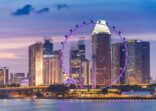Global sustainable fund flows dropped by 36% in the first three months of 2022, but still held up well when compared with the broader market where inflows slumped by 73%, according to a Morningstar sustainable fund flows update.
As inflation concerns and the war in Ukraine unnerved investors, global sustainable funds attracted $97bn of net new money in the first quarter, compared with $150.3bn of inflows in Q4 2021, reports ours sister publication, ESG Clarity.
This is the sharpest quarterly slowdown in sustainable fund net inflows over the past three years. However, sustainable flows were more resilient to market headwinds than the conventional market, where the global fund universe “nosedived” 73% from $517bn in the final quarter of last year to $138bn in Q1.
The Morningstar note said: “Sustainable funds are currently facing macroeconomic headwinds, including inflationary pressures, rising interest rates and market volatility stemming from the Russian invasion of Ukraine, which translated into a decline in net new investments in the first quarter. Nonetheless, inflows in sustainable funds held up better than those of the broader market.”
Global sustainable fund assets also declined 4% with the volatile market impact from $2.9trn at the end of last year to $2.8trn. However, year-on-year, the universe expanded by 38%.
Fund launches in the sustainable world also waned with an estimated 227 new products brought to market globally, a 28% decline compared with the 316 new entrants in Q4 2021. Morningstar noted that Q1 launches have historically been lower, and it is likely the figure will be restated in future reports as more launches are identified. In addition, groups continued to repurpose existing funds into sustainable mandates, albeit at a slower pace.
US
The US is the second largest market for sustainable funds, housing 12% of global sustainable fund assets through March 2022.
However, during Q1, net flows into US sustainable funds posted their fourth consecutive decline, falling $10bn.
“That is 26% less than in the previous quarter and half of the all-time record, nearly $22bn, set one year ago in the first quarter of 2021,” the update said.
But again, when compared with the broader US funds market, demand for sustainable offerings showed higher resilience during the first quarter of 2022, where flows dipped by 65% to $85.7bn affecting both active and passive strategies alike.
Morningstar explained: “In recent years, investor preference has shifted towards low-cost passive funds: over the past three years, passive strategies have attracted about two thirds of quarterly sustainable fund flows on average. However, the split last quarter was close to 50-50, with passive funds netting $5.7bn for the period.”
Still, eight out of the 10 funds attracting the most flows in Q1 were passives, with the Invesco Floating Rate ESG AFRAX product topping the charts.
“Having only repurposed to a sustainable mandate in the second half of 2020, this fund has seen strong early adoption by the market. In the face of rising interest rates, investors may seek to use floating-rate bonds as a hedge, helping this fund garner assets.”
Europe
Europe continued to dominate the global sustainable fund landscape with 82% of sustainable fund assets held on the Continent, “which also remains by far the most developed and diverse ESG market,” said the note.
It attracted shy of $78bn in net flows, a 37% drop on Q4’s $124bn of new money. Again, this was less than the overall market, where conventional funds saw $21bn in outflows.
“As demonstrated in the past, as well as in 2020 at the start of the Covid-19 pandemic and once again in the first quarter of 2022, sustainable fund flows seem to be more resilient in times of market volatility than their traditional peers,” said Morningstar’s update.
Fixed income products “unsurprisingly” saw the sharpest drop in flows, down 60, while investors continued to favor equities and allocation funds.
Four of the 10 best-selling sustainable funds in the first quarter were new products: SPP USA Plus; Multi Manager Access—Green, Social and Sustainable Bonds; Northern Trust FGR Fund—Emerging Markets Custom ESG Equity Index; and ASR Duurzaam Wereldwijd Aandelen Fonds.
Interestingly, nine out of the 10 best-selling funds were actively managed, and seven out of the best funds with the biggest outflows were passive strategies.
Asia Ex-Japan
Morningstar noted China’s data was not available at the time of publication, so it used fourth-quarter 2021 data as a proxy for a first-quarter 2022 estimation.
In a flip of activity elsewhere in the world, Q1 net flows in Asia ex-Japan and China were significantly higher than the $34m in net inflows in fourth-quarter 2021, at $911m into sustainable funds. Taiwan saw the highest flows followed by South Korea.
Meanwhile, India, Thailand and Hong Kong saw the largest decreases.
Total assets held steady at $71bn.

















